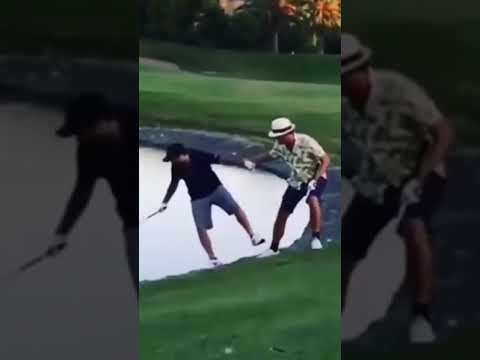How To Play Golf On Wet Ground: The Essential Guide, Golfing Tips For Beginners.
The greatest games of golf are not played in great weather. The mark of a truly great golfer is one who is not rattled by weather and can still stay consistent in whatever weather types that mother nature throws at him. However, everyone knows that playing the game of golf on wet ground is difficult and can hamper your ability to perform your “normal” set of golf.
How do you play golf on wet ground? To play golf on damp ground, you need to plan, make observations of the course, and adapt your playing style and attitude. Some strategies for playing golf on the wet ground include scouting the weather out, swinging within yourself, using more club on approach, checking the greenside conditions, and keeping a positive attitude.
However, playing the game of golf on wet conditions and wet ground can help you to play more within yourself and take your time. This essential guide will give you the best tips and tricks from PGA tour professionals about how to approach a day of golf on wet ground, how to plan for it, and how to play on it.
Why Is It More Difficult To Play Golf On Wet Ground?
According to one of golf’s most famous players from history, Robert Tyre “Bobby” Jones wrote about soft golf courses that, “There can be little question that the great mass of golfers in the United States prefers their greens very soft. Such a condition makes the play much easier for all classes of players. It is, in a great measure, responsible for the fact that tournament scoring is uniformly lower in the United States than on seaside links in the British Isles.”
If the score of professional tournament play is affected by wet conditions, the amateur or novice golfer will struggle mightily. Some of the reasons for it being more difficult to play golf on the damp ground include things that happen only in wet weather. These things include “plugged” balls, feeling that you have to hit “thin” shots, less roll on the fairway, more damage to the grass with carts, and even makes chip shots much more difficult.
Playing Golf On Wet Ground: “Plugged” Balls.
You just hit one of your best shots of the day, and as it sails, you are confident that this is the hole where you start to make your move at a personal best on the course. However, the ball strikes the fairway and only bounces a few feet from where it landed. Wet conditions on the golf course can be terrible for golfers who rely on the bounce and roll of the fairway to carry their drives.
A strong indication that the conditions of the wet ground are hampering your playing ability is when the ball is “plugged.” When you go to your second shot, a plugged ball will be a ball that is either partially or entirely covered with moisture and grass particles. Plugged balls indicate that the wet ground is affecting your golf game and that you should consider changing your approach for that day.
Playing Golf On Wet Ground: Feeling You Have To Hit “Thin” Instead Of “Fat” Shots
When striking the ball during your shot, the term for how much blade you use to strike the ball is described as “fat” or “thin.” A fat shot is one in which the club is hitting the ground before hitting the ball. A fat shot off of the wet soil can be disturbing as you will probably pull up a tuft of grass and barely get any power into your shot. With this in the back of your mind, golfers ten to shoot “thin” shots off of the wet ground. A thin shot is a shot where you are striking the top half of the ball and usually causes a low line of a shot that tends to slice.
How To Fix A Thin and Fat Shot.
Unfortunately, the fear of hitting a fat shot on the wet ground of a golf course is a real fear that many golfers have. Overcompensating to a thin shot is not the answer, but many use this approach to make the shot feel better. According to an article in Golf Digest Magazine, professional golfer Jeff Ritter describes in detail a drill that you can do. The drill should help you to work on adapting to wet ground conditions and keep your swing accurate.
During a practice range session, Ritter says there are two drills to work on for fat and thin shots. The first drill is to move your left shoulder downwards in the direction of the ball during your backswing. Once this feels comfortable, start to adjust the second part of the swing in which you should rotate the right shoulder in the direction of the ball during your downswing. Rotate your lower body to the course of your shot aim before you make this shoulder move on the downswing.
READ MORE
golf,
golf course,
golf cart,
golf club,
golf near me,
golf shoes,
golf wang,
golf bag,
golf ball,
golf world ranking,
golf le fleur,
golf simulator,
golf elbow,
golf vw,
golf digest,
golf shirt,
golf handicap,
golf r,
golf range,
golf club set,
near golf course,






